Propagating begonias is actually quite simple and easy. This can be done by tip cutting, by rhizome, or by leaf cuttings. Rooting tips (the plant tops) is simple, and can be done in much the same way as rooting tip cuttings for other plants (see, for example, the lesson on kohleria). Sections, of begonia rhizomes (that thick, scaly, stem that grows along the soil surface) is also easy and can be done in much the same was as for other rhizomatous plants (see, for example, the lesson on rhizomes elsewhere on these pages).
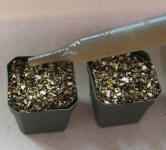
Rooting begonia leaves is much the same as rooting violet leaves but, in some ways, is easier.
First, fill a pot with your rooting mix. Ours is basically our normal potting mix with a lot more vermiculite and perlite. The point is, make sure this mix is very loose and porous. Don’t pack the soil in the pot. When moistened, the soil should not sink on it’s own, but can be easily pressed down with your fingers.
Add enough (lightly fertilized) water so that soil is moist, but not soggy.
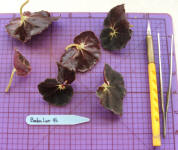
Here are some tools that will come in handy. A cutting board. This can be as simple as a piece of wood or sheet of hard plastic. You can find a good one at your area craft store or office supply store. A sharp knife or razor. We use modelling knives (“exacto” blades) or scalpel. Begonia leaves are thin and paper-like, so to cut them easily and neatly, you’ll need a sharp knife.
Tweezers are also handy, since they will allow you to grasp the leaf parts more easily than you can with your fingers. Also, have some way of identifying your cuttings–a plastic plant label works fine.
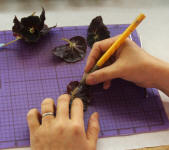
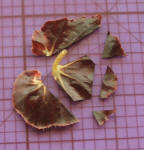
Using your sharp knife, cut your begonia leaf into sections. The center section, where the leaf petiole is attached, will be rooted much like a African violet leaf.
The outer parts of the leaf can be cut into “triangles” or wedges. Each of these leaf wedges can then be rooted as you would a leaf without a petiole. Begonias will root easily–like streptocarpus, almost any part of the leaf, placed in soil “cut-side” down, will root.
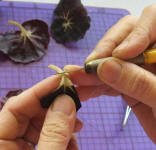
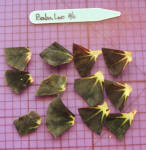
Much like we would an African violet leaf, we trim the petiole at a 45-degree angle (cut side up), about 1/4″ from the base of the leaf blade.
The remaining leaf sections are cut into wedges. You’ll notice that many of these don’t even have petioles. We will root them, however, with the center or inside, of the leaf down into the soil–on this variety, the yellow “eye” of the leaf tells where the center was (not all are this obvious).
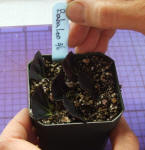
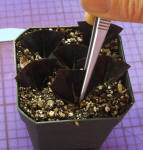
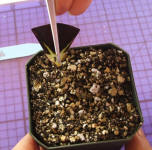
Root the begonia leaves much like you would an African violet leaf. Press them into the soil petiole (leaf stem) side down, or center-side down (for the wedges without petiole attached).
Gently firm soil around base of each (don’t “press” hard). Label your pot!
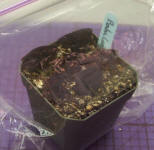
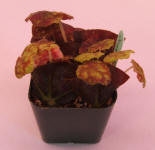
Once you’ve rooted your begonia leaves, place the pot and leaves into a clear container (a plastic baggie works well) and place where it gets some light (but not hot, intense light).
In a couple of months, you’ll begin to see plantlets sprouting from your cuttings. When they are large enough that you can confidently separate them, they can be potted individually into their own pots.
8 COMMENTS
- TabathaApril 15, 2021 3:54 pmGreat demonstration thankyou. Quick question..do they need to be under plastic and do I water them as well over that first month? My plant room has a clear light roof and is a heat trap and the begonias like it (though I lost one recently to grey mildew spotting that spread over the whole plant.)Reply
- Violet BarnApril 16, 2021 1:46 pmWe grow them under cover. Soil needs to be moist, but not soggy. The additional humidity keeps the cuttings from being stressed, and we don’t need to worry about the pots going dry–since the cuttings have no roots in the beginning, any period of dryness will mean the end of them. Once they root, this is less important. If you have high humidity, and are very good about not letting soil dry, covering isn’t needed.
- SandraAugust 13, 2020 3:49 pmI would like to know if the small plastic salad or fruit bowl, after cleaning of course would be good to root begonias and violets. they have the clear plastic lids attached to cover the plantings.Reply
- Violet BarnAugust 13, 2020 4:00 pmSure. We’ve seen this done.
- TaraNovember 19, 2019 6:59 pmMu leaf cuttings keep rotting! What am I doing wrong?! No hot, direct light, not too cold.Reply
- Violet BarnNovember 25, 2019 10:38 amLikely they have been kept too wet. Goal is moist–not soggy nor dry.
- TerriMarch 24, 2017 8:24 pmThank you for all your advice and the pictures are so helpful I have worked with violets and now I want to try begonias.Reply
- mildred forrestFebruary 28, 2017 8:15 amI bought a begonia at the Hartford flower show and delighted to find your product.
thanks a lot
